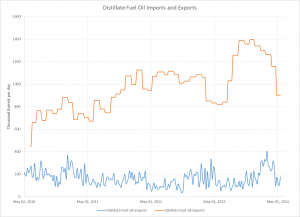Week 1 Blog Post:
Blog 1: Please go to the eia.gov website(link is external) and find the most recent data about the supply of petroleum fuels. Once you have a good understanding of the data, write a blog post to review the most recent supply of petroleum fuels from the data given at eia.gov and comment on how petroleum refining addresses environmental concerns from combustion of petroleum fuels in internal combustion engines. Your post should be 1-2 pages long or between 500-600 words.
As our nation’s population increases so does our demand for energy. In the U.S. with petroleum currently being used as the number one source for energy generation, it is in very high demand. The petroleum field is growing which can have both positive and negative effects. It creates jobs and lowers (even though it isn’t doing so much currently) the price of gasoline, which is our nations #1 consumed bi-product of crude oil. The number of barrels produced per day is consistently growing. It is currently at its highest peak since back in October of 1973. Also with a higher production of crude oil we are also increasing our exports which is good for our economy. However, it is not so good in the aspect of its rising price and also harmful emissions and bi-products.
From eia.gov’s most recent spreadsheet of supply and disposition based off of March 2014, the U.S. is currently producing on average 18,526 thousand barrels a day of crude oil and petroleum products. 3,858 of which are exports being almost 21% of our overall produced in the field. There is also 2,378 thousand barrels a day of NGPL’s and LPG’s produced with only 415 (17%) being exports. It should be noticed too however that we are currently importing roughly 50% of what we are producing. In my own opinion, I believe that we should take the money that we are spending on imports and use it to create renewable power plants. Slowly cut it back until our imports hit zero. Purchasing sources of energy from other countries is doing nothing but hurting our nation’s economy by putting us further into debt. We can fully supply our nation’s energy from within our own borders with the technology that has come about.
I did see however, that crude oils have different quality characteristics. Dependent upon where they come from the crude oils have different density (API gravity) and sulfur contents, which range from about 0-3.5%. Density ranges from light to heavy and sulfur content ranges from sweet to sour. Light and sweet crude oils are priced higher than heavy and sour crude oils. This is because both gasoline and diesel fuel, which are two of the primary bi-products, are more easily refined from light and sweet crude. It appears that the best quality crude oil comes from Algeria and Malaysia. Maybe this explains why we import crude oil, because we are importing a more desirable crude than what we are exporting.
In the internal combustion engines petroleum refining addresses environmental concerns because the more and more it gets refined, the less harmful to the environment it becomes. It contains fewer C-C bonds and becomes easier to break apart or even combust. Because of this, these fuel sources when burned will have a fewer amount of emissions that could possibly harm the environment.
Info from: http://www.eia.gov/dnav/pet/pet_sum_snd_d_nus_mbblpd_m_cur.htm


